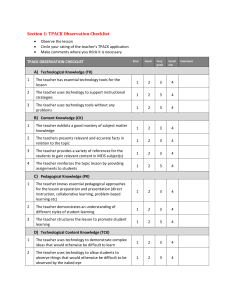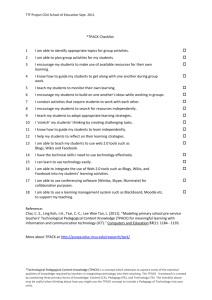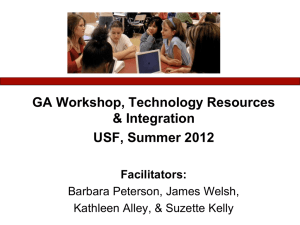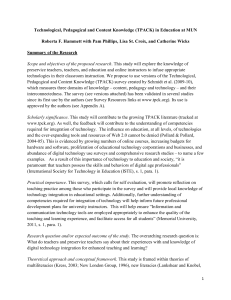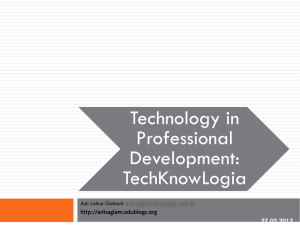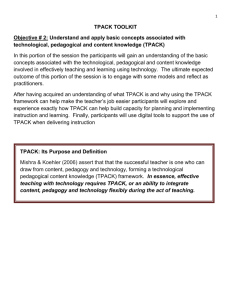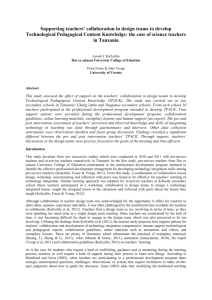Issues with Technology Integration
advertisement
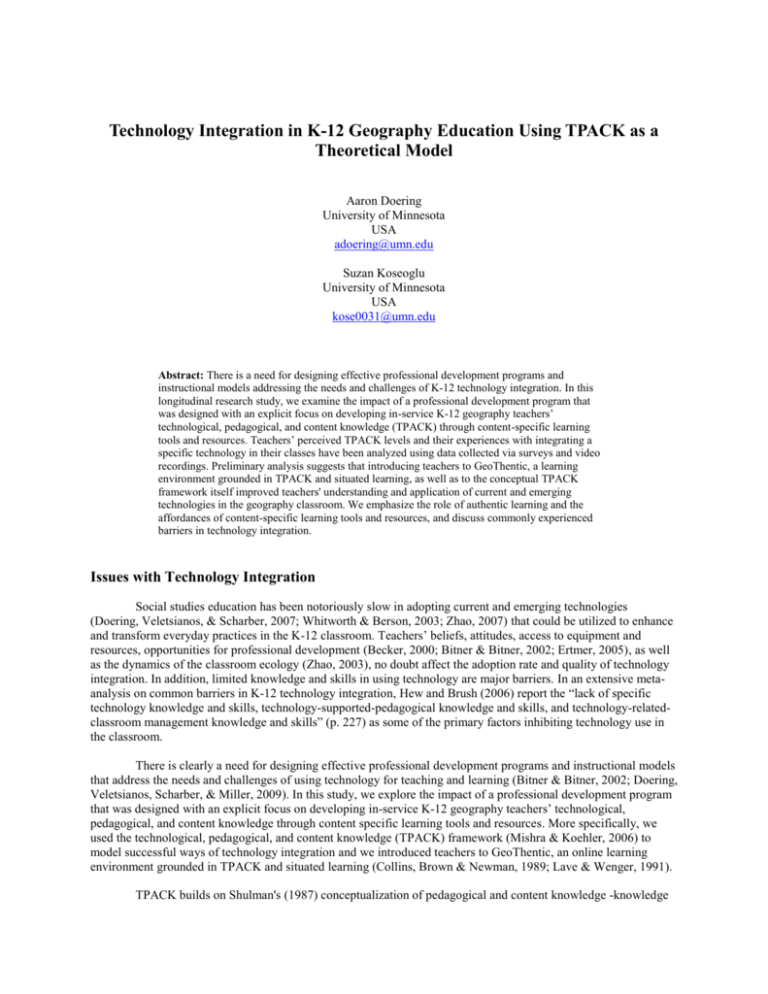
Technology Integration in K-12 Geography Education Using TPACK as a Theoretical Model Aaron Doering University of Minnesota USA adoering@umn.edu Suzan Koseoglu University of Minnesota USA kose0031@umn.edu Abstract: There is a need for designing effective professional development programs and instructional models addressing the needs and challenges of K-12 technology integration. In this longitudinal research study, we examine the impact of a professional development program that was designed with an explicit focus on developing in-service K-12 geography teachers’ technological, pedagogical, and content knowledge (TPACK) through content-specific learning tools and resources. Teachers’ perceived TPACK levels and their experiences with integrating a specific technology in their classes have been analyzed using data collected via surveys and video recordings. Preliminary analysis suggests that introducing teachers to GeoThentic, a learning environment grounded in TPACK and situated learning, as well as to the conceptual TPACK framework itself improved teachers' understanding and application of current and emerging technologies in the geography classroom. We emphasize the role of authentic learning and the affordances of content-specific learning tools and resources, and discuss commonly experienced barriers in technology integration. Issues with Technology Integration Social studies education has been notoriously slow in adopting current and emerging technologies (Doering, Veletsianos, & Scharber, 2007; Whitworth & Berson, 2003; Zhao, 2007) that could be utilized to enhance and transform everyday practices in the K-12 classroom. Teachers’ beliefs, attitudes, access to equipment and resources, opportunities for professional development (Becker, 2000; Bitner & Bitner, 2002; Ertmer, 2005), as well as the dynamics of the classroom ecology (Zhao, 2003), no doubt affect the adoption rate and quality of technology integration. In addition, limited knowledge and skills in using technology are major barriers. In an extensive metaanalysis on common barriers in K-12 technology integration, Hew and Brush (2006) report the “lack of specific technology knowledge and skills, technology-supported-pedagogical knowledge and skills, and technology-relatedclassroom management knowledge and skills” (p. 227) as some of the primary factors inhibiting technology use in the classroom. There is clearly a need for designing effective professional development programs and instructional models that address the needs and challenges of using technology for teaching and learning (Bitner & Bitner, 2002; Doering, Veletsianos, Scharber, & Miller, 2009). In this study, we explore the impact of a professional development program that was designed with an explicit focus on developing in-service K-12 geography teachers’ technological, pedagogical, and content knowledge through content specific learning tools and resources. More specifically, we used the technological, pedagogical, and content knowledge (TPACK) framework (Mishra & Koehler, 2006) to model successful ways of technology integration and we introduced teachers to GeoThentic, an online learning environment grounded in TPACK and situated learning (Collins, Brown & Newman, 1989; Lave & Wenger, 1991). TPACK builds on Shulman's (1987) conceptualization of pedagogical and content knowledge -knowledge that all teachers need to know for successful teaching- and reframes the "essential qualities of knowledge required by teachers for technology integration in their teaching" (Mishra & Koehler, 2006, p. 1017) by introducing technology knowledge as an additional domain. This study builds on previous TPACK research within geography (G-TPACK) (Doering & Veletsianos, 2007; Doering, Veletsianos, Scharber, & Miller, 2009) and conceptualizes the development and application of TPACK as a dynamic process tied to contextual factors. We address the following research questions: (1) To what extent did in-service geography teachers’ perceived technological, pedagogical, and content knowledge change, if any, after a week-long professional development program that focused explicitly on TPACK? (2) What were teachers’ overall perceptions of technology integration before and after the week-long professional development program? (3) In what ways was teachers’ theoretical knowledge of the TPACK framework reflected in their actual classroom practices? Context The Teaching Minnesota Standards to Experience Geography Institute was designed to develop in-service geography teachers’ TPACK within geography, as well as its general application in the K-12 classroom. A weeklong face-to-face training was offered in two sessions: one to middle school teachers and one high school teachers. Teachers received the same technology training and shared an online social networking space, in which they participated in joint discussions and social activities. The workshop sessions focused on assessment skills, geography content, geospatial technologies, instructional strategies, and academic standards and benchmarks appropriate for the grade level teachers were teaching. During the technology sessions teachers were first introduced to Google Earth and other similar Geographical Information Systems (GIS). The next day, teachers spent a full day working on GeoThentic, “an online teaching and learning environment for K-12 geography teachers and students that focused on real-world issues (e.g., global warming), content-specific technologies (Google Earth), and appropriate pedagogies (e.g., problem-based learning)" (Doering, Scharber, Miller, & Veletsianos, 2009). Teachers were encouraged to experiment with GeoThentic in their classes and received ongoing technical support in using the program through the online networking platform and via e-mails. Finally, towards the end of the workshop, teachers received a final training on other technology tools that could be utilized in the geography classroom. As part of the program, teachers were required to integrate a specific technology of their choice in their classes during the four months following the initial training and were asked to share their experiences with the program designers and the other program participants via a digital presentation. Research Design We used a longitudinal research design and divided our study into two phases. During the first phase, we employed a convergent parallel design (Creswell & Clark, 2011). This mixed methods study was followed up approximately 4 months after the initial professional development program with a qualitative study that focused primarily on teachers' experiences with implementing a specific self-chosen technology in their classrooms. Participants Phase 1. An invitation to participate in a pre-survey was sent to all teachers who registered in the institute. Forty-four teachers completed the pre-survey before the institute started. All participants were K-12 in-service teachers teaching geography at the middle or high school level. The majority of participants were female (n = 27) and had been teaching for 10 years or more (n = 30). Most teachers had 5 or more years of experience using technology in their classrooms (n = 29). Thirty-four teachers completed the post-survey. Pre- and post-survey data were paired for 22 participants. Phase 2. After approximately 4 months, 20 teachers who participated in the initial professional development program presented their experiences with implementing a specific technology in their classes to other program participants and program directors, and completed a final survey. Data Sources and Measures Phase 1. Quantitative measures. Single pre-and post-surveys were used to collect data on in-service teachers' metacognitive awareness of their TPACK. We adapted the “Survey of Pre-service Teachers' Knowledge of Teaching and Technology” (Schmidt, Baran, Thompson, Koehler, Mishra, & Shin, 2009) to measure changes in in-service teachers’ perceived TPACK. Participants were asked to rate each survey item on a five-point Likert-type scale, where 0 was assigned to strongly disagree and 4 to strongly agree. Reliability measures ranged from .8 to .92 for the pre-survey, and .76 to .94 for the post-survey. Qualitative Measures. Six items addressing demographic information and three open-ended questions tapping into teachers' overall experiences and perceptions using technology in educational settings were included in each survey in order to gain a more comprehensive understanding of the participants’ experiences with technology integration. Phase 2. Findings from Phase 1 informed the design of a final survey. The final survey was primarily designed to serve as a metacognitive tool rather than a measurement instrument. The survey questions tapped into teachers' practical understanding of TPACK and the persistency of common barriers that were identified during the first phase of the study. Additionally, video recordings of teachers’ presentations were used to examine the ways teachers’ theoretical knowledge in the TPACK framework were reflected in their actual classroom practices. Data Analysis Quantitative data analysis. Quantitative data analysis was performed using descriptive and inferential statistics. An alpha level of .05 was used for all statistical tests, and dependent t-test results were corrected for Type I errors using the Bonferroni method. Qualitative data analysis. Qualitative pre- and post-survey data collected during the first phase of the study were analyzed using grounded theory (Strauss & Corbin, 1998). We observed that the emergent categories were similar in the pre-and post-data, except the perceived gains that were reported in response to the first open-ended question in the post-survey. In our study, we report pre- and post-qualitative findings together; however, we also discuss notable differences between the pre-and post-data. We report preliminary descriptive data from the second phase of the study. The given quotes are chosen according to their relevancy to the discussion context and the richness of information they provide. All names are pseudonyms. Video recordings of teachers’ presentations are currently being analyzed using the verbal analysis method (Chi, 1997). Procedure Phase 1. The pre- and post-surveys were administered online one week before and one week after teachers completed the professional development training. All participants received an email from program designers and were asked to participate in the survey. Participants remained anonymous in their responses and were not asked any questions that could directly reveal their true identity. Phase 2. Teachers received the final survey in paper format after they had given their presentations. Video recordings were completed during the presentations. Findings -Phase 1 Quantitative findings We first report descriptive data (Table 1) of the pre- and post-survey results below. Table 1. Summary of descriptive statistics of the pre- and post-surveys. Technology Knowledge (TK) Content Knowledge (CK) Pedagogical Knowledge (PK) Pedagogical Content Knowledge (PCK) Technological Content Knowledge (TCK) Technological Pedagogical Knowledge (TPK) Technological Pedagogical Content Knowledge (TPACK) Pre-Survey Results N Mean SD 44 2.05 .85 Post-Survey Results N Mean SD 35 2.26 .81 44 2.72 .72 35 3.07 .54 44 3.20 .42 35 3.24 .46 44 3.02 .51 35 3.20 .53 44 2.20 .88 35 2.89 .68 44 2.62 .62 35 3.03 .56 44 2.48 .85 35 3.17 .51 Our hypothesis was that there would be a change in in-service teachers’ perceived TPACK. We used dependent t-tests to examine differences between the pre- and post-survey data (Table 2). Tests for these priori hypotheses were conducted using Bonferroni adjusted alpha levels of .007 per test (.05/7). The results of paired ttests suggested that there were statistically significant changes in teachers’ TK, TCK, TPK and TPACK; however, there were not significant changes in their CK, PK, and PCK. Table 2. Results of paired-samples t-tests. Scale Technology Knowledge (TK) Content Knowledge (CK) Pedagogical Knowledge (PK) Pedagogical Content Knowledge (PCK) Technological Content Knowledge (TCK) Pre Test: Mean (SD) Post Test: Mean (SD) 2.08 (.87) 2.41 (.75) Post-Pre Test: Mean (SD) .33 (.43) MatchedPair t (df=21) p-value (twotailed) r 3.51 .002* .61 2.88 (.60) 3.11 (.54) .23 (.51) 2.10 .048 .42 3.18 (.43) 3.22 (.46) .04 (.40) .45 .658 .1 2.95 (.58) 3.18 (.50) .23 (.61) 1.74 .096 .35 2.32 (.78) 2.91 (.61) .59 (.73) 3.78 .001* .64 Technological 2.63 Pedagogical (.66) Knowledge (TPK) Technological Pedagogical 2.59 Content (.73) Knowledge (TPACK) *: Significant when p < .007 3.10 (.48) .47 (.46) 4.89 .000* .73 3.23 (.43) (.64) .66 4.54 .000* .70 Qualitative findings Due to proceedings page limitations, we have left out direct quotes from teachers that support findings in each category below, and instead summarize briefly our findings within each category. The words and phrases that are quoted in each category are stemming from our collected data and teachers' own words. Using technology to enhance teaching and learning The first central theme that emerged from the qualitative data was the perceived benefits of using technology to enhance teaching and learning. This theme was predominantly evident in the pre- and post-survey responses to the second open-ended question, “What do you like most about using technology for teaching geography?”, revealing two major categories: providing opportunities for authentic learning (pre = 44%, post = 50%) and fostering student engagement (pre = 37%, post = 36%). a. Providing authentic learning opportunities. The benefit of providing authentic learning activities and resources utilizing technology were pronounced heavily both in the pre-and post-data. The data suggested that compared to traditional print-based learning resources, authentic technology tools allow teachers to enhance their content with "current," "real-world," and "instantaneous" data that lead to significant gains in student engagement and students’ understanding of geographical concepts. One of the most frequently commented benefits of teaching with technology is the ability to immerse students in real-life problems and issues, which in turn enables students to examine curricular issues from a “broad” perspective, make "real-life connections," and grasp the "interconnectedness" of our world. b. Fostering student engagement. This theme was strongly evident in both pre-and post-survey responses. The impact of interactive and hands-on aspects of technology on student engagement and motivation was particularly emphasized. Teachers noted that the introduction of technology into the learning environment could immediately raise students’ "interest level." Using technology as a “hook” was more emphasized in the post-survey data. Barriers in technology integration The second central theme that emerged from the qualitative data was barriers in technology integration. This theme was predominantly evident in the pre- and post-survey responses to the third open-ended question, “What are some challenges you have experienced, or anticipate to experience in the future, with using technology for teaching geography?”, revealing three major categories: limited access to equipment (pre = 43%, post = 45%), limited technology knowledge (pre = 27%, post = 24%), and limited technical support and infrastructure (pre = 13%, post = 17%). a. Limited access to equipment. Limited access to classroom equipment was the most frequently commented barrier. Teachers commonly reported problems with accessing computers. In most cases, teachers had concerns about using computer labs for technology-related activities. In some cases, the dependence on school resources prevented teachers from bringing new ideas and practices into the classroom. b. Limited technology knowledge. Teachers reported the need to develop their technology knowledge both for relatively simple technical tasks (e.g., setting up equipment before a class activity, storing information, downloading software programs) and for more complex tasks requiring knowledge in other areas (e.g., pedagogy), such as being able to understand a software program in-depth and utilize it to its fullest potential. Teachers also noted the need to have time and opportunities for professional development in order to “keep up” with technology changes. c. Limited technology support and infrastructure. Problems with technology support and inadequate infrastructure were concerns for most teachers, especially after the training was over. Data suggested that when teachers lacked problem-solving skills or when they felt they did not have control over using the technologies they needed, they became more dependent on technology support, and perceived that as challenge. Teachers needed technology support people staff who were “willing and able to assist in a timely manner,” as well as a reliable infrastructure capable of running geographic information systems (GIS) software such as Google Earth. Teachers complained of “computer server failures and blocks,” “limited bandwith,” “sporadic” infrastructure, and not being able to download programs without technology support’s approval. Findings -Phase 2 Preliminary findings from phase 2 are reported in this section. Video recordings of teachers’ presentations are currently being analyzed to examine the ways teachers’ theoretical knowledge of the TPACK framework were reflected in their actual classroom practices. In the final phase of the study, teachers presented their experiences with implementing a specific technology of their choice in their classes. The tools that teachers used for implementation were Geothentic: Build a Hospital Module (n = 11), GeoThentic: Avian Flu Module (n = 4), Google Earth (n = 3), social media (n = 2), Google maps (n = 2), ArcGIS (n = 2), MassGIS (n = 1) and other various online graphs and maps (n = 3). All GeoThentic modules utilized Google Earth. In response to the survey question, “Do you believe that teachers need to know all three knowledge domains equally well for every classroom activity utilizing technology? Can you provide an example illustrating your point?,” 13 out of 20 teachers replied that they did not. Eight of these teachers noted, however, that it was beneficial to be good at all three domains. For example, one teacher responded: No, not for every classroom activity. With GeoThentic for example, I think you need to know the technology more than the content, since the content is so provided, structured, and guided. Clearly, though, mastery of all three realms is better for education. Teachers who believed that TPACK was equally important in every classroom activity utilizing technology emphasized the growing use of technology in schools across content areas, the imperative role of technology in globalization, and the negative consequences of not having sufficient technology and/or pedagogy knowledge when teaching. Discussion Our first hypothesis was that there would be significant changes in teachers' TPACK after the initial weeklong professional development program. We observed mean increases in all domains with significant changes in TK, TPK, TCK and TPACK. Qualitative data from the first phase revealed that the majority of teachers were aware of the various benefits of using digital technology for teaching and learning and were eager to use technology in their classes, but they had major interrelated barriers in achieving their goals. Identified barriers are consistent with previous literature (Bitner & Bitner, 2002; Ertmer, 2005; Hew and Brush, 2006; Zhao, 2007) with a notable difference: we did not observe any resistance to change in our sample, except one teacher who implicitly stated that he/she did not like new technologies. It is, however, not very clear if there were hidden barriers—such as pre-constructed beliefs about what teaching and learning should look like—that confounded the strength of the visible barriers. Yet, the qualitative findings draw our attention to the limitation of only examining changes in teachers' TPACK to evaluate the effectiveness of teacher practices in technology integration. Our data confirms previous findings on barriers in technology integration considerably, and suggests that being able to use technology effectively depends on individual factors, such as positive engagement with technology, motivation to develop one’s abilities, the extent of one’s technology knowledge, and environmental factors such as the availability of technical support, opportunities for professional development, and access to equipment and modern infrastructure. As evidenced in the qualitative findings from the first phase of the study, technology is vital to bringing real-life experiences and issues into the classroom, fostering student engagement, and enhancing students’ understanding of geographical concepts and issues through hands-on and personalized activities. However, without practical knowledge, the affordances of technology can increase the number of everyday problems that teachers experience in the classroom, as reflected in the identified barriers in our study. Using advanced GIS tools in the ordinary classroom, for example, require high bandwidth, reliable machines to run on, and sound technological knowledge. Most importantly, teachers need to know how to use technologies and their capabilities in a pedagogically sound way for seamless integration. Preliminary findings from the last phase of the study suggest that explicitly introducing the TPACK framework in the context of content-specific learning tools and resources enabled teachers to experiment with technology integration while still developing their abilities in TPACK and gaining practical knowledge. Additionally, we observed that GeoThentic, a learning environment grounded in TPACK, has the potential to change the perspective that teachers need to be experts in all three knowledge domains equally well before integrating technology successfully in their classroom. In other words, such learning environments can model for teachers how to integrate technology effectively even if they are not advanced in TPACK. For example, in GeoThentic, teachers are provided with pedagogical strategies to implement the activities along with step-by-step instructions describing how to use the learning environment and the GIS technologies introduced. Teachers’ comments showed that although in some cases additional technology support in implementing new technologies is needed, such scaffolds can help teachers to overcome frequently experienced barriers such as limited technology knowledge, understanding of pedagogical applications of content-specific technologies, as well as technical problem solving. Conclusion We reported our experiences with a professional development program that focused explicitly on the TPACK framework. The preliminary analysis led us to conclude that the program was effective in improving teachers’ TPACK, as well as in increasing their metacognitive awareness of the individual knowledge domains and the individual domain’s relationship to each other. We suggest explicitly introducing teachers to the TPACK framework and investing in designing instructional tools and resources based on the TPACK framework. Finally, for future research, we encourage the reader to think about the expanding boundaries of curricular content. In geography, the learning tools have become increasingly authentic, allowing students to get immersed in “real-world and ill-structured problem scenarios based on genuine, valid, and legitimate needs, specifications, data, and expectations” (Doering & Miller, 2010). We argue that these learning activities have the potential to create shared experiences and reframe the traditional roles of students and teachers as learners developing their abilities in collaboration with others. We ask, if the learning context is increasingly becoming more complex, directly dealing with real-life experiences, and if shared experiences reframe our conceptions of teaching and learning (2010), should we always expect teachers to know more than students? Perhaps we also need to ask, do teachers need to know technology, pedagogy, and content equally well in every context, or should the learning context redefine where teachers are situated, and should be situated, within TPACK? We argue that teachers do not need to be experts in technology, pedagogy, and content equally well for successful integration and draw emphasis on gaining practical knowledge that helps teachers solve their everyday problems in the classroom. References Doering, A., & Miller, C. (2010). The layers of authenticity: Designing for learner experience. In Proceedings of the Association for the Advancement of Computing in Education (AACE) ELearn Conference, Orlando, FL. Doering, A., Scharber, C., Miller, C., & Veletsianos, G. (2009). GeoThentic: Designing and assessing with Technological Pedagogical Content Knowledge. Contemporary Issues in Technology and Teacher Education [Online serial], 9(3). Doering, A., & Veletsianos, G. (2007). An investigation of the use of real-time, authentic geospatial data in the K-12 classroom. Journal of Geography, 106(6), 217-225. Doering, A., Veletsianos, G., & Scharber, C. (2007). Coming of age: Research and pedagogy on geospatial technologies within K-12 social studies education. In A. J. Milson & Alibrandi, M. (Eds.), Digital geography: Geo-spatial technologies in the social studies classroom (pp. 213-226). Charlotte, NC: Information Age Publishing. Doering, A., Veletsianos, G., Scharber, C., & Miller, C. (2009).Using the Technological, Pedagogical, and Content Knowledge framework to design online learning environments and professional development. Journal of Educational Computing Research, 41(3), 319-346. Bitner, N., & Bitner, J. (2002). Integrating technology into the classroom: Eight keys to success. Jl. of Technology and Teacher Education, 10(1), 95-100. Becker, H. J. (2000). Findings from the teaching, learning, and computing survey: Is Larry Cuban right? Education Policy Analysis Archives, 8(51). Retrieved from http://epaa.asu.edu/ojs/article/view/442 Chi, M. T. H. (1997). Quantifying qualitative analyses of verbal data: A practical guide. The Journal of the Learning Sciences, 6(3), 271-351. Creswell, J. W., & Clark, V. L. P. (2011). Designing and conducting mixed methods research. Thousand Oaks, CA: Sage Publications. Collins, A., Brown, J., & Newman, S. (1989). Cognitive apprenticeship: Teaching the craft of reading, writing, and mathematics. In L. Resnick (Ed.), Knowing, learning, and instruction: Essays in honor of Robert Glaser (pp. 453–494). Hillsdale, NJ: Lawrence Erlbaum Associates. Ertmer, P. A. (2005). Educational Technology Research & Development, 53(4), 25-39. Hew, K. F., & Brush, T. (2007). Integrating technology into K-12 teaching and learning: Current knowledge gaps and recommendations for future research. Educational Technology Research & Development, 55(3), 223252 Lave, J., & Wenger, E. (1991). Situated learning: Legitimate peripheral participation. Cambridge: Cambridge University Press. Mishra, P., & Koehler, M. J. (2006). Technological pedagogical content knowledge: A framework for teacher knowledge. Teachers College Record, 108(6), 1017-1054. Schmidt, D. A., Baran, E., Thompson, A. D., Koehler, M. J., Mishra, P., & Shin, T. S. (2009). Survey of preservice teacher's knowledge of teaching and technology. Retrieved from http://mkoehler.educ.msu.edu/unprotected_readings/TPACK_Survey/Schmidt_et_al_Survey_v1.pdf Shulman, L. S. (1987). Knowledge and teaching: Foundations of the new reform. Harvard Educational Review, 57(1), 1-22. Strauss, A., & Corbin, J. (1998). Basics of qualitative research: Techniques and procedures for developing grounded theory, 2nd Edition. Thousand Oaks, CA: Sage Publications. Whitworth, S. A., & Berson, M. J. (2003). Computer technology in the social studies: An examination of the effectiveness literature (1996-2001). Contemporary Issues in Technology and Teacher Education [Online serial], 2(4). Retrieved from http://www.citejournal.org/vol2/iss4/socialstudies/article1.cfm Zhao, Y. (2007). Social studies teachers' perspectives of technology integration. Jl. of Technology and TeacherEducation, 15(3), 311-333. Zhao, Y., & Frank, K. A. (2003). Factors affecting technology uses in schools: An ecological perspective. American Educational Research Journal, 40(4), 807-840.
